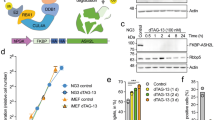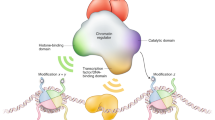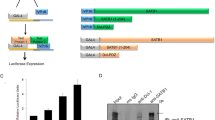Abstract
Lysine methylation of histones is recognized as an important component of an epigenetic indexing system demarcating transcriptionally active and inactive chromatin domains. Trimethylation of histone H3 lysine 4 (H3K4me3) marks transcription start sites of virtually all active genes1,2,3,4. Recently, we reported that the WD40-repeat protein WDR5 is important for global levels of H3K4me3 and control of HOX gene expression5. Here we show that a plant homeodomain (PHD) finger of nucleosome remodelling factor (NURF), an ISWI-containing ATP-dependent chromatin-remodelling complex, mediates a direct preferential association with H3K4me3 tails. Depletion of H3K4me3 causes partial release of the NURF subunit, BPTF (bromodomain and PHD finger transcription factor), from chromatin and defective recruitment of the associated ATPase, SNF2L (also known as ISWI and SMARCA1), to the HOXC8 promoter. Loss of BPTF in Xenopus embryos mimics WDR5 loss-of-function phenotypes, and compromises spatial control of Hox gene expression. These results strongly suggest that WDR5 and NURF function in a common biological pathway in vivo, and that NURF-mediated ATP-dependent chromatin remodelling is directly coupled to H3K4 trimethylation to maintain Hox gene expression patterns during development. We also identify a previously unknown function for the PHD finger as a highly specialized methyl-lysine-binding domain.
This is a preview of subscription content, access via your institution
Access options
Subscribe to this journal
Receive 51 print issues and online access
$199.00 per year
only $3.90 per issue
Buy this article
- Purchase on Springer Link
- Instant access to full article PDF
Prices may be subject to local taxes which are calculated during checkout




Similar content being viewed by others
References
Santos-Rosa, H. et al. Active genes are tri-methylated at K4 of histone H3. Nature 419, 407–411 (2002)
Schneider, R. et al. Histone H3 lysine 4 methylation patterns in higher eukaryotic genes. Nature Cell Biol. 6, 73–77 (2004)
Bernstein, B. E. et al. Genomic maps and comparative analysis of histone modifications in human and mouse. Cell 120, 169–181 (2005)
Pokholok, D. K. et al. Genome-wide map of nucleosome acetylation and methylation in yeast. Cell 122, 517–527 (2005)
Wysocka, J. et al. WDR5 associates with histone H3 methylated at K4 and is essential for H3 K4 methylation and vertebrate development. Cell 121, 859–872 (2005)
Pray-Grant, M. G., Daniel, J. A., Schieltz, D., Yates, J. R. & Grant, P. A. Chd1 chromodomain links histone H3 methylation with SAGA- and SLIK-dependent acetylation. Nature 433, 434–438 (2005)
Sims, R. J. et al. Human but not yeast CHD1 binds directly and selectively to histone H3 methylated at lysine 4 via its tandem chromodomains. J. Biol. Chem. 280, 41789–41792 (2005)
Santos-Rosa, H. et al. Methylation of histone H3 K4 mediates association of the Isw1p ATPase with chromatin. Mol. Cell 12, 1325–1332 (2003)
Tsukiyama, T. & Wu, C. Purification and properties of an ATP-dependent nucleosome remodeling factor. Cell 83, 1011–1020 (1995)
Barak, O. et al. Isolation of human NURF: a regulator of Engrailed gene expression. EMBO J. 22, 6089–6100 (2003)
Tsukiyama, T., Becker, P. B. & Wu, C. ATP-dependent nucleosome disruption at a heat-shock promoter mediated by binding of GAGA transcription factor. Nature 367, 525–532 (1994)
Mizuguchi, G., Tsukiyama, T., Wisniewski, J. & Wu, C. Role of nucleosome remodeling factor NURF in transcriptional activation of chromatin. Mol. Cell 1, 141–150 (1997)
Hamiche, A., Sandaltzopoulos, R., Gdula, D. A. & Wu, C. ATP-dependent histone octamer sliding mediated by the chromatin remodeling complex NURF. Cell 97, 833–842 (1999)
Mizuguchi, G., Vassilev, A., Tsukiyama, T., Nakatani, Y. & Wu, C. ATP-dependent nucleosome remodeling and histone hyperacetylation synergistically facilitate transcription of chromatin. J. Biol. Chem. 276, 14773–14783 (2001)
Xiao, H. et al. Dual functions of largest NURF subunit NURF301 in nucleosome sliding and transcription factor interactions. Mol. Cell 8, 531–543 (2001)
Badenhorst, P., Voas, M., Rebay, I. & Wu, C. Biological functions of the ISWI chromatin remodeling complex NURF. Genes Dev. 16, 3186–3198 (2002)
Badenhorst, P. et al. The Drosophila nucleosome remodeling factor NURF is required for Ecdysteroid signaling and metamorphosis. Genes Dev. 19, 2540–2545 (2005)
Li, H. et al. Molecular basis for site-specific read-out of histone H3K4me3 by the BPTF PHD finger of NURF. Nature advance online publication, doi:10.1038/nature04802 (21 May 2006).
Méndez, J. & Stillman, B. Chromatin association of human origin recognition complex, cdc6, and minichromosome maintenance proteins during the cell cycle: assembly of prereplication complexes in late mitosis. Mol. Cell. Biol. 20, 8602–8612 (2000)
Milne, T. A. et al. MLL targets SET domain methyltransferase activity to Hox gene promoters. Mol. Cell 10, 1107–1117 (2002)
Shi, X. et al. ING2 PHD domain links histone H3 lysine 4 methylation to active gene repression. Nature advance online publication, doi:10.1038/nature04835 (21 May 2006).
Bienz, M. The PHD finger, a nuclear protein-interaction domain. Trends Biochem. Sci. 31, 35–40 (2006)
Dhalluin, C. et al. Structure and ligand of a histone acetyltransferase bromodomain. Nature 399, 491–496 (1999)
Ragvin, A. et al. Nucleosome binding by the bromodomain and PHD finger of the transcriptional cofactor p300. J. Mol. Biol. 337, 773–788 (2004)
Zhou, Y. & Grummt, I. The PHD finger/bromodomain of NoRC interacts with acetylated histone H4K16 and is sufficient for rDNA silencing. Curr. Biol. 15, 1434–1438 (2005)
Dignam, J. D., Lebovitz, R. M. & Roeder, R. G. Accurate transcription initiation by RNA polymerase II in a soluble extract from isolated mammalian nuclei. Nucleic Acids Res. 11, 1475–1489 (1983)
Zegerman, P., Canas, B., Pappin, D. & Kouzarides, T. Histone H3 lysine 4 methylation disrupts binding of nucleosome remodeling and deacetylase (NuRD) repressor complex. J. Biol. Chem. 277, 11621–11624 (2002)
Nishioka, K. et al. Set9, a novel histone H3 methyltransferase that facilitates transcription by precluding histone tail modifications required for heterochromatin formation. Genes Dev. 16, 479–489 (2002)
Acknowledgements
We thank E. Bernstein, W. Herr and E. Duncan for critical reading of the manuscript, O. Gozani for communicating unpublished results, and D. Reinberg, W. Herr, R. Roeder and J. Tamkun for CHD1, WDR5, MLL and ISWI antibodies, respectively. T.S. thanks A. H. Brivanlou for support. J.W. is a D. Runyon CRF Fellow, T.A.M. is a Canadian Institutes of Health Research Fellow, and J.L is an ACS Postdoctoral Research Fellow. C.W., J.L. and H.X. are supported by the US National Cancer Institute Intramural Research Program, and S.Y.K. and P.B. are supported by the BBSRC. C.D.A. acknowledges a MERIT Award from the NIH.
Author information
Authors and Affiliations
Corresponding authors
Ethics declarations
Competing interests
Reprints and permissions information is available at npg.nature.com/reprintsandpermissions. The authors declare no competing financial interests.
Supplementary information
Supplementary Notes
This file contains Supplementary Figures 1–4, Supplementary Methods and additional references. (PDF 2180 kb)
Rights and permissions
About this article
Cite this article
Wysocka, J., Swigut, T., Xiao, H. et al. A PHD finger of NURF couples histone H3 lysine 4 trimethylation with chromatin remodelling. Nature 442, 86–90 (2006). https://doi.org/10.1038/nature04815
Received:
Accepted:
Published:
Issue Date:
DOI: https://doi.org/10.1038/nature04815
This article is cited by
-
Crosstalk between colorectal CSCs and immune cells in tumorigenesis, and strategies for targeting colorectal CSCs
Experimental Hematology & Oncology (2024)
-
Alzheimer’s Disease-Related Epigenetic Changes: Novel Therapeutic Targets
Molecular Neurobiology (2024)
-
Protein acetylation sites with complex-valued polynomial model
Frontiers of Computer Science (2024)
-
Abnormal H3K4 enzyme catalytic activity and neuronal morphology caused by ASH1L mutations in individuals with Tourette syndrome
European Child & Adolescent Psychiatry (2024)
-
BAP18 facilitates CTCF-mediated chromatin accessible to regulate enhancer activity in breast cancer
Cell Death & Differentiation (2023)
Comments
By submitting a comment you agree to abide by our Terms and Community Guidelines. If you find something abusive or that does not comply with our terms or guidelines please flag it as inappropriate.



